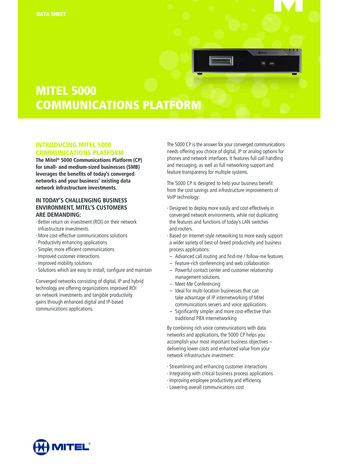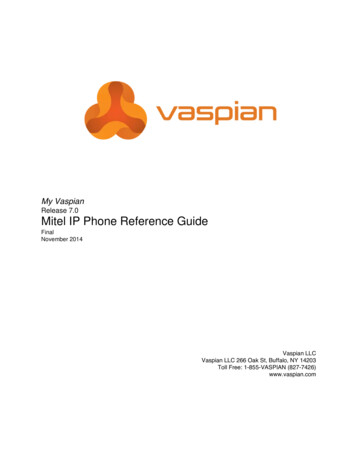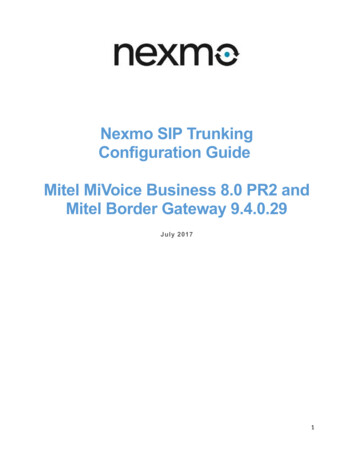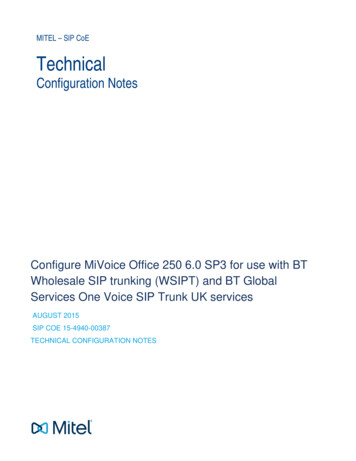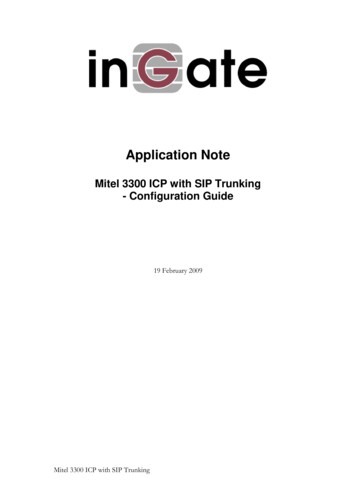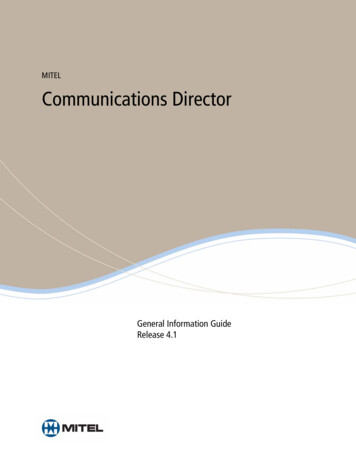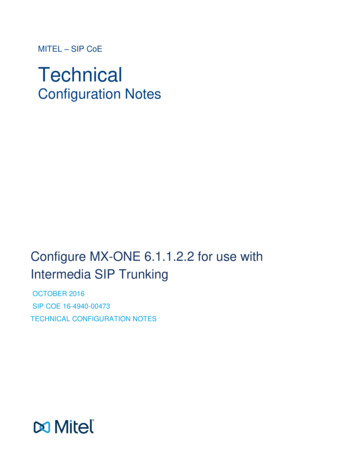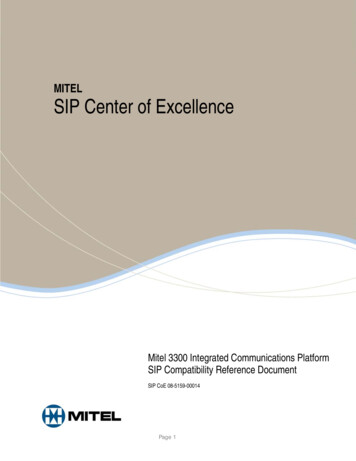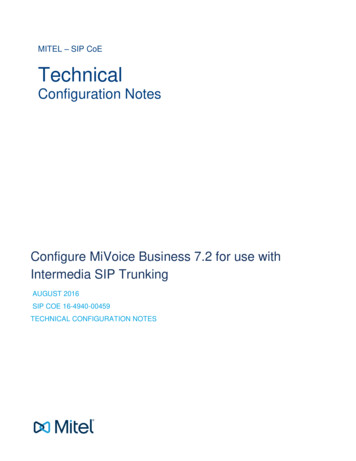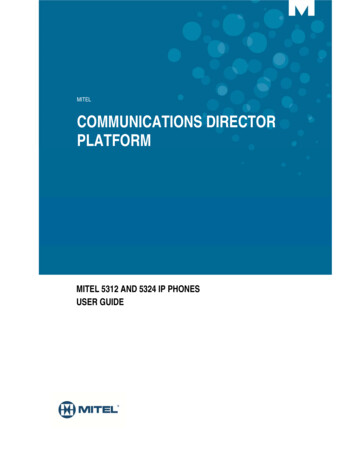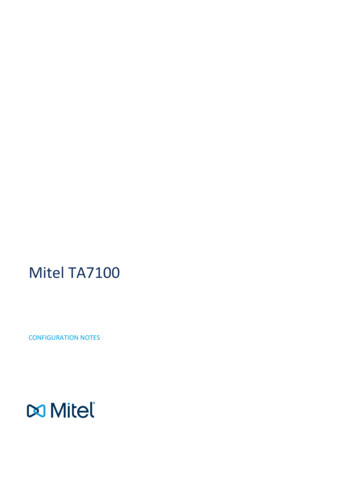
Transcription
Mitel TA7100CONFIGURATION NOTES
NOTICEThe information contained in this document is believed to be accurate in all respects but is not warrantedby Mitel Networks Corporation (MITEL ). Mitel makes no warranty of any kind with regards to thismaterial, including, but not limited to, the implied warranties of merchantability and fitness for a particularpurpose. The information is subject to change without notice and should not be construed in any way asa commitment by Mitel or any of its affiliates or subsidiaries. Mitel and its affiliates and subsidiariesassume no responsibility for any errors or omissions in this document. Revisions of this document ornew editions of it may be issued to incorporate such changes.No part of this document can be reproduced or transmitted in any form or by any means - electronic ormechanical - for any purpose without written permission from Mitel Networks Corporation.TRADEMARKSThe trademarks, service marks, logos and graphics (collectively "Trademarks") appearing on Mitel'sInternet sites or in its publications are registered and unregistered trademarks of Mitel NetworksCorporation (MNC) or its subsidiaries (collectively "Mitel") or others. Use of the Trademarks is prohibitedwithout the express consent from Mitel. Please contact our legal department at legal@mitel.com foradditional information. For a list of the worldwide Mitel Networks Corporation registered trademarks,please refer to the website: http://www.mitel.com/trademarks. Copyright 2016, Mitel Networks CorporationAll rights reserved
Contents1SCOPE . 121.1ACRONYMS AND DEFINITIONS11.2SETUP DESCRIPTION11.3BASICS OF SECURITY EXCHANGES1INSTALLATION . 432.1INSTALLING A TLS-ENABLED SERVER/PROXY42.2ABOUT CERTIFICATES42.3INSTALLING CERTIFICATES ON THE MITEL UNIT42.4MITEL UNIT CONFIGURATION62.5SIP GATEWAY CONFIGURATION62.6ENABLING SECURE SIGNALLING (TLS)72.7ENABLING SECURE MEDIA (SRTP)9TROUBLESHOOTING . 123.13.23.33.43.5ENABLING TLS DEBUGGING ON WIRESHARKREGISTER MESSAGES NOT BEING ANSWEREDSERVER INTERNAL ERROR (OR SIMILAR MESSAGES)MIKEY AND SDES MISMATCHANNEXESiii1214141617
TA7102 CONFIGURATION NOTES1SCOPEThis document describes the steps required to configure the Mitel unit loaded with the DGWv2.0 firmware for secure SIP signalling and secure media (SRTP) operation. This is not acomplete key-exchange, TLS or general security tutorial. For more information on thosetopics, please see the links section.1.11.2ACRONYMS AND DEFINITIONSRTPReal Time ProtocolSDPSession Description ProtocolSIPSession Initiation ProtocolSRTPSecure Real Time ProtocolSSLSecure Socket LayerTLSTransport Layer SecurityWiresharkNetwork sniffing and capture toolSETUP DESCRIPTIONIn this scenario, the endpoints used are Mitel Terminal Adapters. The units must be loadedwith Dgw v2.0. We will use the freely available openSIPS (www.opensips.org) as the SIPproxy and configure it for TLS operation.1.3BASICS OF SECURITY EXCHANGESAt the level at which we are working, establishing a TLS connection is fairly straightforward.In practice, at a lower level, there are quite a lot of additional complications to guard againstvarious possible attacks.This is the overall exchange in order to build the TLS link and bring it “up”:The client (Mitel Terminal Adapters) initially connects to the server on a configured TCP port(16000 is the default source port, the destination port is the configured SIP proxy port).151/1531-ANF901 14 Uen B3 2016-03-221
TA7102 CONFIGURATION NOTESThe client sends a “Client Hello” message with the supported TLS/SSL protocol version,cipher specifications and compression algorithms.The server replies with a “Server Hello” message with the selected cipher and the servercertificate.The client verifies the server certificate (validations are configured via theTlsCertificateValidation variable).The client generates a secret and encrypts it with the server’s public key. This encryptedsecret is then sent to the server.The client and the server use the secret to create the same symmetric encryption key.The client and the server switch to encrypted communication by using the previously agreedcipher and the key just established.This brief exchange can be seen in the following Wire shark capture.When obtaining the server certificates during the early negotiation, the following informationwill be checked by the client: the server signature,151/1531-ANF901 14 Uen B3 2016-03-222
TA7102 CONFIGURATION NOTES the CA (certification authority) who signed the certificate, validate that the server identified in the certificate is the same as the one that presentedit, The expiration date of the certificate.If any of these steps fails, your TLS link will not go “up”. For those familiar with HTTPS, this isessentially the same procedure but using a SIP server/proxy instead of a HTTPS server.151/1531-ANF901 14 Uen B3 2016-03-223
TA7102 CONFIGURATION NOTES2INSTALLATION2.1INSTALLING A TLS-ENABLED SERVER/PROXYUsing two Mitel Terminal Adapters gateways connected back-to-back using a SIP trunkwould be sufficient to demonstrate the use of the new security features. However, we preferto demonstrate the configuration of the units and test scenarios in a more real-worldenvironment by using a separate TLS-enabled SIP proxy. For this purpose, we have chosenopenSIPS as it is free and easy to configure for basic use.For more information on setting up openSIPS, please refer to the openSIPS installationdocumentation at www.opensips.org/docs. Otherwise skip this section.Please note that (at the moment of this writing) by default open sips is configured to keep theTLS links up for a period of 2 minutes. We have made a small code modification that allowsthe links to stay up for 120 minutes. See the annex for more information.2.2ABOUT CERTIFICATESIn order to enable TLS on the Mitel Terminal adapters, you will need at least a CA certificatethat will validate that the certificate presented by the server is valid. This certificate must beuploaded to the Mitel Terminal adapters. In order to use the Wire shark features that aredescribed later, a copy of the SIP server certificate containing its private key (this will beused to decrypt the TLS) will also be needed. The certificates need to be in ITU X.509format.For certificate creation, we recommend the FAQ page from the openssl ER32.3INSTALLING CERTIFICATES ON THE MITEL UNITNavigate to the Management- Certificates section.Activate unsecured certificate transfer.Select the certificate type Other, then click Browse. A pop-up explorer window appears andallows you to browse your local file system to locate the server’s CA certificate file (usuallywith a .crt extension), using format X.509.When the certificate is loaded, the required services must be restarted. This can be done byfollowing the provided link at the top of the web page.151/1531-ANF901 14 Uen B3 2016-03-224
TA7102 CONFIGURATION NOTESIt is important to know the distinction between a “Host” and “Other” certificate.An “Other” certificate is simply a CA certificate used to validate the certificate of the server towhich TA7102 is trying to connect.A “Host” certificate is a server certificate that is required if TA7102 acts as a TLS server andpresents its certificate to other clients. An example of this would be two Mediatrix gatewayswith no SIP proxy in the middle. At least one of the units will require a Host certificate. If onlyone unit has a Host certificate, the calls will be allowed in only one direction (Unit 1 calls Unit2). For bi-directional calls, both Mitel Terminal adapters would require a Host certificate.Note that by default it is not possible to upload a Host certificate without first clicking onActivate unsecured certificate transfer. This is because the certificate upload will be donein clear text, which means the private key will be susceptible to interception!Important: Mitel recommends uploading Host certificates from a PC that is connecteddirectly to the gateway.Note! Warning: Since certificates have a start date and expiry date, the use of NTP(Network Time Protocol) is now mandatory on the Mitel Terminal adapters when using thesecurity features. To setup the NTP server, go to the Network- Host section andconfigure your NTP server accordingly.151/1531-ANF901 14 Uen B3 2016-03-225
TA7102 CONFIGURATION NOTES2.4MITEL UNIT CONFIGURATION2.5SIP GATEWAY CONFIGURATIONBefore using TLS, the SIP gateway needs to be properly configured. To do that, go to theSIP- Gateways section.In this example, the gateway called “OpenSIPS” is listening on port 5062. To configure thegateway, click the Servers tab.151/1531-ANF901 14 Uen B3 2016-03-226
TA7102 CONFIGURATION NOTESFor settings that are gateway-specific, use the Gateway Specific sections. In the previousexample, the settings are valid only for the “OpenSIPS” gateway. Both the SIP Registrar andSIP Proxy are configured to 192.168.120.11 on port 5062.2.6ENABLING SECURE SIGNALLING (TLS)The Mitel unit does not support mixing TLS and non-TLS links. This means that it is notpossible to configure separate gateways (SIP- Gateways) using secure and non-securelinks. Once TLS is enabled, it is enabled for all configured gateways.Go to the SIP- Transport tab and simply enable TLS, click Submit and follow the link to startthe appropriate service. Please notice the configuration field for the previously discussed port16000.151/1531-ANF901 14 Uen B3 2016-03-227
TA7102 CONFIGURATION NOTESIf the TLS link is established, the “Ready” LED on the Mitel unit turns on steady green. Thestatus of the TLS link can also be found in the web page and in the syslog.A syslog message will be sent saying “establishing persistent connection”151/1531-ANF901 14 Uen B3 2016-03-228
TA7102 CONFIGURATION NOTES2.7ENABLING SECURE MEDIA (SRTP)Now that encrypted signaling is configured, the media streams can also be encrypted andsecured. Without encryption, RTP is still vulnerable to interception.Do as follows:1. Go to the Telephony - CODECs page and enable secure RTP by changing the Mode toSecure.2. Choose a Key Management Protocol. The Mitel unit supports both MIKEY and SDES.3. Choose the encryption algorithm. Currently the Mitel unit supports AES with 128 bits. Thechoice “NULL” will not encrypt the RTP. This should be selected only for debuggingpurposes.4. Click Submit.Note! Note: T.38 packets will never be encrypted. Setting “Allow unsecured T.38 with secureRTP” will allow using T.38, otherwise it would be rejected.151/1531-ANF901 14 Uen B3 2016-03-229
TA7102 CONFIGURATION NOTESIn the following Wireshark trace, the Mikey parameters are sent in the INVITE SDP.Enabling SDES instead of Mickey, the INVITE will be slightly different. SDES parameters willbe added to the SDP Media Attributes instead of the Session Attributes.151/1531-ANF901 14 Uen B3 2016-03-2210
TA7102 CONFIGURATION NOTESThe RTP/SAVP is a flag which states that the endpoint is attempting to initiate a securemedia connection. Seethe text in red in the above example.151/1531-ANF901 14 Uen B3 2016-03-2211
TA7102 CONFIGURATION NOTES3TROUBLESHOOTINGTo troubleshoot when using security, Wireshark must be configured for TLS sniffing.The following are a few examples of issues that may be encountered while configuring TLS.3.1ENABLING TLS DEBUGGING ON WIRESHARKOnce the TLS link is up, it is no longer possible to read the SIP packets as they are TLSencrypted. To debug TLS, Wireshark needs to be configured to decrypt them. For this step,the public keys associated with the server certificate are needed.Do as follows:1. In the Edit/Preferences dialog, select the Protocols/SSL node and fill the RSA key list.The field specifies the binding between an IP address, a port, a protocol and a RSAdecryption key. Enter the IP address of the server, the SIP port and the path to the filecontaining the server private key. Several such bindings may be specified by separatingthem with a semi-colon “;”.Example: The server is located at 192.168.120.11 and listens on port 5062192.168.120.11,5062,sip,C: \certificates\192.168.120.11.keyWhen having difficulty decrypting SIP packets, the “SSL debug file” may be used todetermine what is going wrong.2. Start the Wireshark capture.151/1531-ANF901 14 Uen B3 2016-03-2212
TA7102 CONFIGURATION NOTES3. Restart the SIPEP service on the Mitel unit or simply reboot the Mitel unit. This willenable the TLS renegotiation.4. When the unit is rebooted and the “Ready” LED is lit on the Mitel unit, stop the packetcapture.5. Using the “ssl” filter in the capture should show the SIP packets between the twoendpoints.151/1531-ANF901 14 Uen B3 2016-03-2213
TA7102 CONFIGURATION NOTES3.2REGISTER MESSAGES NOT BEING ANSWEREDIn the first example, TLS is enabled on one of the Mitel Terminal adapters and not on thesecond gateway.The REGISTER requests from the second gateway are not being answered. This is becausethe proxy is expecting the SIP message to be SSL encapsulated. Simply restart theWireshark capture and enable TLS on the second gateway. Restart the required services3.3SERVER INTERNAL ERROR (OR SIMILAR MESSAGES)Some servers/proxies will require Interop variables to be enabled. For example, the defaultopenSIPS installation requires adding the SIP transport field in the registration and contactheaders. To do so, set the following variables to Enable.Below is a SIP Register message from one endpoint (192.168.120.30) that has the TLStransport in the Contact Header disabled and also a SIP Register message from the otherendpoint that has the Contact Header enabled (192.168.120.12).151/1531-ANF901 14 Uen B3 2016-03-2214
TA7102 CONFIGURATION NOTESRegister from 192.168.120.30REGISTER sip:192.168.120.11:5062 SIP/2.0Via: SIP/2.0/TLS192.168.120.30:16000;branch ards: 70From: sip:100@192.168.120.11:5062 ;tag 2ce647ee6cTo: sip:100@192.168.120.11:5062 Call-ID: a1b5ddebef59717aCSeq: 151405030 REGISTERAuthorization: Digestusername "100",realm "192.168.120.11",nonce ,uri "sip:192.168.120.11:5062",response "c42b06827c08018c8c34cd0696269193"Contact: sip:100@192.168.120.30:16000 (NO TRANSPORT METHOD IN HEADER)User-Agent: Mitel TA7102i/v2.0.26.451 4102-AS-D2000-1Content-Length: 0Invite from 192.168.120.12INVITE sip:100@192.168.120.11:5062 SIP/2.0Via: SIP/2.0/TLS192.168.120.12:16000;branch ards: 70From: sip:101@192.168.120.11:5062 ;tag e437e6cd75To: sip:100@192.168.120.11:5062 Call-ID: 822ebcc6433a7565CSeq: 1793624545 INVITEAllow: INVITE, ACK, BYE, CANCEL, REFER, NOTIFY, UPDATEContact: sip:101@192.168.120.12:16000;transport tls Min-SE: 1800Session-Expires: 3600Supported: timerSupported: replacesUser-Agent: Mitel TA7102i/v2.0.26.451 4102-AS-D2000-1Content-Type: application/sdpContent-Length: 300151/1531-ANF901 14 Uen B3 2016-03-2215
TA7102 CONFIGURATION NOTESHere is the REGISTER for a subsequent working call with the Interop variable enabled.REGISTER sip:192.168.120.11:5062 SIP/2.0Via: SIP/2.0/TLS192.168.120.30:16000;branch ards: 70From: sip:100@192.168.120.11:5062 ;tag 586e1a152bTo: sip:100@192.168.120.11:5062 Call-ID: 83216656d213ac84CSeq: 1378359313 REGISTERAuthorization: Digestusername "100",realm "192.168.120.11",nonce ,uri "sip:192.168.120.11:5062",response "214ede0b4eda7b7e6d6d2e03eb013755"Contact: sip:100@192.168.120.30:16000;transport tls User-Agent: Mitel TA7102i/v2.0.26.451 4102-AS-D2000-1Content-Length: 03.4MIKEY AND SDES MISMATCHIt is strongly recommended to select only one single key management protocol. In thefollowing example, SDES is configured on endpoint 1 (192.168.120.30) and Mikey onendpoint 2 (192.168.120.12).The gateway 192.168.120.12 will return a SIP 415 Unsupported Media because it is notconfigured for SDES management.151/1531-ANF901 14 Uen B3 2016-03-2216
TA7102 CONFIGURATION NOTESThe following Syslog message should also be seen:syslog: SdpTools [D3A2] Received the wrong key management protocol. Secure streamdisabled.3.5ANNEXESMitel Knowlegde BaseSSL and Certificates ia.org/wiki/X.509 (see links section)Mikey Informationhttp://tools.ietf.org/html/rfc3830SDES IPS Configuration Notestcp conn.h:#define TCP CHILD TIMEOUT pour 0 (avoid response delays)151/1531-ANF901 14 Uen B3 2016-03-2217
TA7102 CONFIGURATION NOTES#define DEFAULT TCP CONNECTION LIFETIME pour 12000 (avoid connection dropsafter 2 minutes of inactivity)opensips.cfg:disable tls nolisten tls:192.168.120.11:5062tls verify server 0tls verify client 0tls require client certificate 0tls method TLSv1tls certificate "/home/user/opensips/etc/opensips/cert.pem"tls private key "/home/user/opensips/etc/opensips/privkey.pem"#tls ca list list.pem"151/1531-ANF901 14 Uen B3 2016-03-2218
Using two Mitel Terminal Adapters gateways connected back-to-back using a SIP trunk would be sufficient to demonstrate the use of the new security features. However, we prefer to demonstrate the configuration of the units and test scenarios in a more real-world environment by using a separate TLS-enabled SIP proxy. For this purpose, we have chosen
